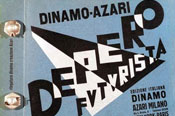The Avant-Garde Applied (1890-1950)
March 30 – July 1, 2012
Fundación Juan March, Madrid
Catalog
Before modern aesthetics appeared at the end of the eighteenth century and with them the so-called autonomy of the fine arts, all art was originally “design”, that is to say “applied arts”, or art “applied” to a function. Historically, the arts have been applied to the most diverse religious, political and social functions, from the cult and celebration of religion to the representation of power or wealth, decoration and leisure. Later, certain movements that arose between the late nineteenth and early twentieth centuries such as the Vienna Secession or the Arts and Crafts movement and, above all, the historical Avant-Gardes —from Futurism to the Bauhaus through Neoplasticism or Constructivism— implied not only an accentuation of the modern autonomy of art but a generalized and radical intent to once again take art into all spheres of life, to transform and configure it based on the ideals of the new. The Avant-Garde returned art’s transformative power to the political and social sectors, to the domestic world of function and decoration, and to the texts of books, magazines and posters as vehicles for the dissemination of ideas, which art had never fully left, but from which the aesthetics and poetics of pure art, the aestheticism and the ideal of l’art pour l’art, had distanced it.
The exhibition The Applied Avant-Garde (1890-1950), displaying more than 700 works–among them original designs, maquettes, preparatory studies and photomontages, posters, books, magazines, postcards, brochures–will reveal the arresting and fascinating visual history of the impact of Avant-Garde ideals in the areas of graphic design and specially typography, from its antecedents in the last decade of the nineteenth century through the first half of the twentieth. The results were manifested —almost simultaneously in a geographical setting as vast as it was interconnected— in such diverse sectors as political and ideological propaganda, advertising and mass media, architecture, urban and interior design, exhibitions, theater, film and photography, among others.
The exhibition, accompanied by a fully illustrated catalogue in both English and Spanish editions, will include the work of more than 100 artists from more than twenty countries: a long list of Avant-Garde artists, typographers and designers, pioneering artists of graphic design such as Max Bill (1908-1994), Fortunato Depero (1892-1960), Oskar Kokoschka (1886-1980), El Lissitzky (1890-1941), Filippo Tommaso Marinetti (1876-1944), Lászlò Moholy-Nagy (1895-1946), Liubov Popova (1889-1924), Aleksandr Rodchenko (1891-1956), Kurt Schwitters (1887-1948), Jan Tschichold (1902-1974) and Theo Van Doesburg (1883-1931), among many others. The featured works come from two important international private collections whose quality and breadth make them worthy of a museum: that of the american Merrill C. Berman, New York, and José María Lafuente from Santander, Spain.
The selection of the works on exhibition, which span more than a half century, is based not only on historical criteria but on the transformative conceptual and thematic approaches of the Avant-Garde and turns on dual axes: the rendering of images and words in Avant-Garde graphic design and in the typographic revolution that this imposed on the field.
